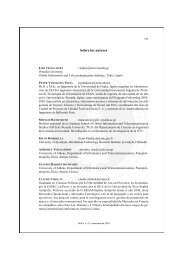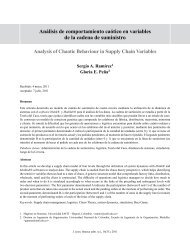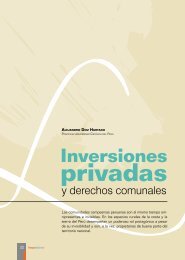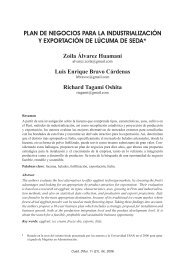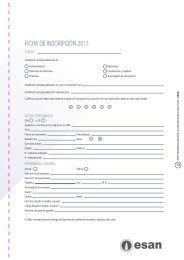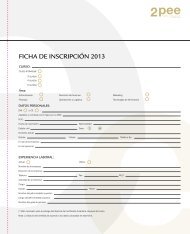re-engineering Agriculture For enhanced Performance ... - SciELO
re-engineering Agriculture For enhanced Performance ... - SciELO
re-engineering Agriculture For enhanced Performance ... - SciELO
You also want an ePaper? Increase the reach of your titles
YUMPU automatically turns print PDFs into web optimized ePapers that Google loves.
46 Journal of Economics, Finance and Administrative ScienceDecember 2010Table 4Results of the long-run Restricted ModelVariable Coefficient Standard Error t- statistics ProbabilityTVLGUAD 0.63078 0.19521 3.23217 0.0034**TVLACMB 0.61847 0.20872 3.44814 0.0052**ECM2 (-1) -0.53171 0.17857 -2.97449 0.0438C -0.11690 0.06517 -1.76676 0.0886Source: Extracted from computer print-out of <strong>re</strong>sultsNote: **= significant at 1%R 2 = 0.5648 R -2 =0.5446 DW= 1.771F-Stat= 8.009 Schwartz Criterion= -0.0087disequilibrium and it was significant at 5%. This<strong>re</strong>sult confirmed significant <strong>re</strong>lationship betweenthe output of the agricultural sector as proxied by theagricultural GDP, and total volume and value of loansguaranteed the agricultural sector. However, theeffects of these two independent variables on agriculturalGDP manifested a year after. This is understandablebecause agricultu<strong>re</strong> has a gestationperiod. The equation for the <strong>re</strong>stricted or under-parameterizedmodel is then specified as follows:DLOG (GDP) = -0.11069 + 0.63078 DLOG (TVLGUAD) + 0.61844D LOG(TVLACMB) -0.53171 ECM2(-1) (7)From the econometric <strong>re</strong>sults, it was shown that theoutput of agricultu<strong>re</strong> proxied by agricultural GDP isinfluenced to varying deg<strong>re</strong>es by a number of factors.In the <strong>re</strong>stricted model, the total number and volume ofloans guaranteed to the agricultural sector we<strong>re</strong> foundto be the only significant factors determining GDP.LESSONS LEARNED FROM THE NIGERIANCREDIT GUARANTEE SCHEMEA number of lessons could be learned from the NigerianACGSF by other countries intending to institute similarprograms. They a<strong>re</strong> as follows:1) The CBN and the FGN a<strong>re</strong> the sponsors of theScheme. While the CBN has been paying upits ag<strong>re</strong>ed contributions to the Fund, the FGNhas persistently been lagging behind in payingup. Given that the FGN is the originator of thepolicy, it has not matched its action with itsstated intention. This may give wrong signals tothe states and local governments as well othercorporate organizations that a<strong>re</strong> now beinginvited to contribute to the Fund under the TrustFund Model. This could be <strong>re</strong>sponsible forthe slightly slow <strong>re</strong>sponse to the invitation toparticipate in the Trust Fund.2) The Nigerian economy has experienced inflationover the years. This has continuously beeneroding the value of the Naira and hence the valueof the Fund. This is what necessitated theupward <strong>re</strong>view of the authorized and paid upcapital as well as the ceilings for the loans thatcould be guaranteed for cooperatives/corporateorganizations and individual large-scale farmerstwice. The ceiling for small-scale farmers’ loan,which is not collateralized, was however onlyinc<strong>re</strong>ased once.3) The<strong>re</strong> is a problem of backlog of unsettledclaims, some of which span over twenty years.This is highly undesirable because it may erodethe confidence of banks in the Scheme. This isprobably <strong>re</strong>sponsible for the poor growth in thenumber of banks participating in the afo<strong>re</strong>mentionedprogram.J. econ. finance adm. sci., 15(29), 2010



